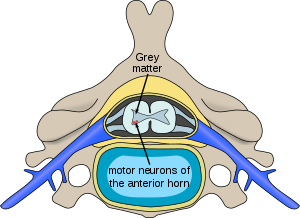Spinal muscular atrophies
| Spinal muscular atrophies | |
|---|---|
 |
|
| Location of neurons affected in spinal muscular atrophies | |
| Classification and external resources | |
| Specialty | neurology |
| ICD-10 | G12 |
| MeSH | D009134 |
Spinal muscular atrophies (SMAs) are a genetically and clinically heterogeneous group of rare debilitating disorders characterised by the degeneration of lower motor neurons (neuronal cells situated in the anterior horn of the spinal cord) and subsequent atrophy (wasting) of various muscle groups in the body. While some SMAs lead to early infant death, other types permit normal adult life with only mild weakness.
Based on the type of muscles affected, spinal muscular atrophies can be divided into:
When taking into account prevalence, spinal muscular atrophies are traditionally divided into:
A more detailed classification is based on the gene associated with the condition (where identified) and is presented in table below.
In all forms of SMA (with an exception of X-linked spinal muscular atrophy type 1), only motor neurons, located at the anterior horn of spinal cord, are affected; sensory neurons, which are located at the posterior horn of spinal cord, are not affected. By contrast, hereditary disorders that cause both weakness due to motor denervation along with sensory impairment due to sensory denervation are known as hereditary motor and sensory neuropathies (HMSN).
In all spinal muscular atrophies, the primary feature is muscle weakness accompanied by atrophy of muscle. This is the result of denervation, or loss of the signal to contract that is transmitted by the motor neurons in the spinal cord. The signal is normally transmitted from the spinal cord to muscle via the motor neuron's axon, but in spinal muscular atrophies either the entire motor neuron or the motor neuron's axon loses the ability to transmit signals to muscles.
...
Wikipedia
